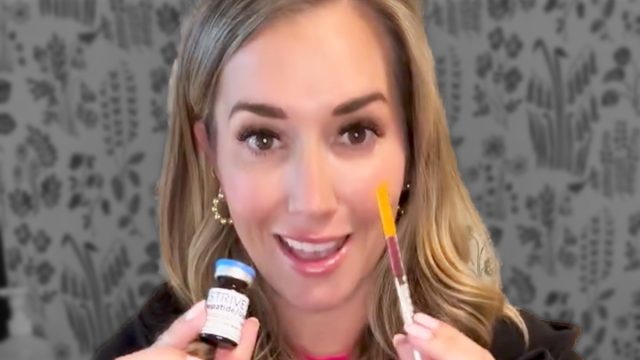10 GLP-1 Medication Lies You Should Stop Believing, Says Nurse

Have you heard a lot of concerning stuff about Ozempic and other GLP-1 weight loss drugs? According to an expert, don't believe everything you hear. Melissa Musso is a Nurse Practitioner and social media influencer who regularly shares information about weight loss drugs. In a new post, she pops the lid on Ozempic lies. "The top 10 lies you've been told about GLP-1s and what's actually true," she writes, revealing that a lot of what she hears "floating around about GLP-1s is wild. Let's clear some things up."
GLP-1s Are a "Quick Fix"
The number one lie? "They're a quick fix," she says. "No, they're just a tool. You still have to put in the work, but the medication makes losing weight actually attainable."
RELATED: 15 Things to Know Before Requesting Ozempic for Weight Loss
You Will Regain All the Weight You Lost
The second lie? "You'll regain all the weight," she says. "The literature says this is not true even if you go off medication, a year later, patients were still below their initial starting weight," she explains.
You Will Lose Muscle
Lie number three: "They make you lose muscle," she says. "Only if you're undereating protein and avoiding strength training. Fix that, and you'll be fine."
They Are Only for Diabetics
"They're only for diabetics," is lie number four. "Nope. FDA-approved for weight loss, too. And 'off label' uses for so much more," she says.
RELATED: 20 Possible Ozempic Side Effects
They Will Take Away Your Hunger
Another common lie? "You'll never feel hungry again," she says. "Sounds like malnutrition waiting to happen. We want to regulate your appetite, not eliminate it."
You Will Only Qualify for Them If You Are Overweight
"You have to be this overweight to qualify," is also not true. "It's not just about BMI—I care more about where we are going and what we are trying to accomplish than I do where you're starting from," she says.
They Are Dangerous
Another fallacy? "They're dangerous," she says. "They're actually wildly safe. That's why so many people are irresponsibly prescribing them and getting away with it."
RELATED: What Happens to Your Body When You Stop Taking Ozempic
You Don't Have to Change Anything After
"You don't have to change anything" is lie number eight. "If you go off meds and return to your baseline lifestyle, you will slowly return to your baseline weight," she says.
They Are Only for Rich Celebrities
Lie nine is "They're for rich celebrities," she says. "Regular people are using them every day. The real problem? Insurance companies making access harder than it should be. Compounds have been helping to close that gap."
RELATED: 20 Things to Avoid While on Ozempic
If You Tried Harder, You Wouldn't Need Them
The final lie? "If you just tried harder, you wouldn't need them," she says. "Weight loss isn't just about willpower—it's so much more and a GLP-1 just helps level the playing field." And if you enjoyed this article, don't miss 20 Incredible Ozempic Success Stories of All Time.




